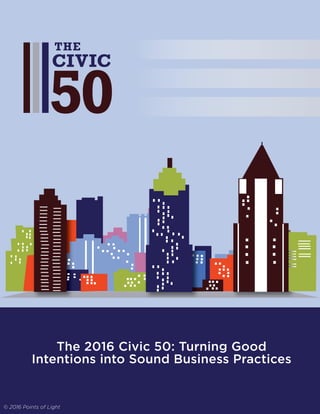This document provides an overview of the 2016 Civic 50 report, which recognizes the 50 most community-minded companies in the US each year. It discusses the history and methodology of the Civic 50, then highlights trends seen among the 2016 winners, including creating a culture of community involvement, leveraging time and talent, strategically connecting purpose to profit, enabling collaboration, and measuring impact. The report also provides best practices from sector leaders and a roadmap for translating good intentions into sound business practices through investment, integration, institutionalization, and impact measurement.




























![28
Featured Essay:
Company as Community
How can we use business as a force for
good? If you go back to the origins of
capitalist philosophy with Adam Smith,
you’ll find that a deep sense of justice
is core to how the marketplace should
function. Yet, as a society we have
become so focused on the invisible hand
of the market that
we have neglected
these moral
sentiments. We
now find ourselves
operating within a
false dichotomy:
maximize profits,
and then give back
a share of those
profits to tackle the social, economic and
environmental problems that face our
communities. The pursuit of profits has
become untethered from probity.
At JUST Capital, we believe there is
another way. In order to tackle society’s
most systemic challenges, traditional
philanthropy can be complemented by
scalable market-oriented solutions. We
exist to harness the immense power of
the markets to channel resources, capital
and talent to address the issues that
matter most to our communities.
We do this by evaluating and ranking the
largest publicly traded companies in the
U.S. based on how JUST they are. We
determine the definition of JUSTness by
conducting extensive market research
to uncover what consumers, employees,
investors and communities value in
corporate behavior. We have reached
over 43,000 people to date in nationally
representative surveys
that are fully mapped
and weighted to the U.S.
census. We then make
the results available
on our web-based
platform, which provides
actionable insights and
tools that corporate
leaders, consumers,
investors – all of us – can use to make
more JUST decisions.
Engaging the largest publicly traded
companies in this effort is crucial because
of their sheer size, scale and influence.
In the U.S. alone, they employ over 30
million people, generate $1.8 trillion of
profit, provide nearly 50 percent of
the nation’s healthcare coverage, and
represent nearly 90 percent of investable
equities. By creating a platform that
can align companies with the views and
values of the public, we take the first step
in breaking down the profit/philanthropy
dichotomy and begin to solve society’s
most intractable problems.
This essay is by Martin Whittaker, CEO of JUST Capital, and Gabi Blumberg, Managing
Director at JUST Capital. JUST Capital is a nonprofit organization established by
a group of distinguished investment and industry leaders to advance the global
sustainability agenda and foster a more “just,” values-led capital market. Their essay
provides a powerful example of the rising tide of stakeholder opinion with which the
Civic 50 must engage.
If [justice] is removed, the
great, the immense fabric
of human society…must in a
moment crumble into atoms.”
- Adam Smith, The Theory of
Moral Sentiments](https://image.slidesharecdn.com/a78027c6-15fc-4de3-bec7-c74b038db043-161211043225/85/2016Civic50_Report_FINAL-29-320.jpg)




















